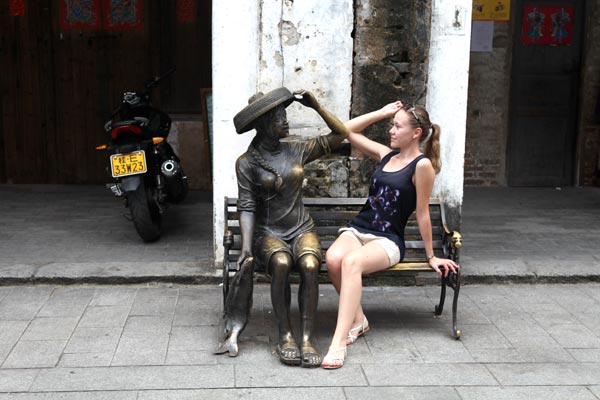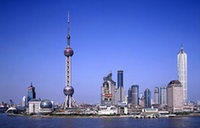New life for an old port
 |
|
The flood of visitors enlivens the historical street.[Photo by Huo Yan / China Daily] |
Residents of Beihai in Guangxi Zhuang autonomous region savor their ancient past as they adapt to changing times, Li Yang reports.
Beihai city of the Guangxi Zhuang autonomous region was once a starting point of the Maritime Silk Road for China's trade with Southeast Asia, South Asia and East Africa after the Song Dynasty (960-1279). Today most of the shops along the main business street near the old fishing port have become bars, coffee shops, eateries and grocers. Locals say the area was very prosperous in the 1930s and again in the '80s, when China was open to the world economically and culturally.
Beihai's position as an international trade portal actually dates back to much earlier than the glory days of the Silk Road. About 400 ancient tombs from Han Dynasty (206 BC-AD 220) have been excavated in Hepu county north of Beihai since the 1970s and thousands more remain untouched underground, rare in South China.
Archaeologists found tens of thousands of copper wares, lacquers, pearls, lynx stones and pottery as burial accessories, which were produced elsewhere and acquired by trade with foreign countries.
The Old Street of Beihai is testimony to its prosperous commercial history, both ancient and recent. The street, 1.5 kilometers long and 9 meters wide, is the longest and best preserved arcade-building street in South China.
It was built in the mid-1800s by Western colonists: Britain, France, Germany, the United States, Italy, Portugal and Belgium set up consulates, churches and hospitals in the street.
The buildings, which nestle each other cheek by jowl, are two or three stories tall and five to six meters wide in their street facades, yet 30 to 40 meters deep. The special design is to shorten the distance between the houses and the fishing ports as well as to enlarge the indoor areas for storage and residence in the busiest commercial street. Most windows, in baroque or Roman styles, feature arches on the top and embossment window pillars on both sides.
Local citizens say it is not that comfortable to live in the buildings, which lack toilets and bathrooms, now that people have modern buildings to live in. Liao Xing, a tenant from the Xinjiang Uygur autonomous region operating a grocery store in the street, says: "The space is so narrow and I separate it into several small bedrooms."
Most of the buildings' facades are mottled with dark green moss and black mildew because of local moisture. Wild flowers and trees take root on the roofs or in the crevices of the old buildings and flourish.
The facades are built with solid stones, but the rest parts of the houses were constructed with bricks, tiles and wood in a Chinese style. The floor slabs and staircases are all made of decay-resistant camphor wood and have stood the test of time.
Many photographers, painters and architects, from home and abroad, have perused the streets to capture intriguing scenes.
Zhang Yezhong, a 62-year-old priest working in the church on Beihai Old Street, says: "These shops were all owned by Chinese. Behind the southern side buildings along the street is four old fishing ports of Beihai. The shops on the south of street sold aquatic products and shops on the north sold daily necessities and marine facilities, such as mooring ropes, fishing nets and canvas."
Chen Yanjing, a 65-year-old resident selling coconut milk in the street, says: "I have lived here all my life. The old residents all hoped the street would be consolidated, because the living environment was very bad."
The street was renovated in 2005 and the muddy road surface was covered with neat slates. Chen was content with her business. "I do not want to move anywhere. The business is good after the street was turned into a tourist spot."
Local government complains that the improvement of public service in Beihai cannot catch up with the sharply rising migrant population. The crematorium, schools and hospitals are all overloaded.
Soccer, dragon boats, martial arts, swimming and fishing are the most important traditional activities for the business community that thrives in the hundreds of shops in the street - all threatened by the arrival of new residents and the departure of old ones, Chen says.
But her 25-year-old daughter disagrees and says: "The Old Street has a new life now".
Beihai is three hours drive from Nanning, the capital of Guangxi Zhuang autonomous region. The Ancient Han Tomb Museum is in Hepu in Beihai’s north suburb. The Old Street is in the south end of the small city on the peninsular end at the Beibu Gulf and neighbors Yintan sea beach, one of the most famous beaches in China for its white sand.
Weizhou Island, 25 square kilometers and 21 nautical miles to the south of Beihai, is the youngest volcanic island in China, worth visiting for its picturesque landscape and a gothic cathedral church built by French missionaries in 1861 with stone, coral, bamboo and wood, which still serves as a chapel for 2,000 Catholics living on the island. Enjoy the seafood in some bigger restaurants in Beihai, because the small eateries here are famous for ripping off tourists.


















